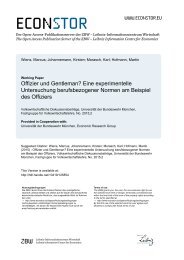DISCUSSION
n?u=RePEc:iza:izadps:dp10283&r=exp
n?u=RePEc:iza:izadps:dp10283&r=exp
You also want an ePaper? Increase the reach of your titles
YUMPU automatically turns print PDFs into web optimized ePapers that Google loves.
4.1 Motivation<br />
Our analysis of goal setting is motivated by two literatures in behavioral economics: the literature<br />
on present bias and the literature on loss aversion. The first literature suggests that people lack<br />
self-control because they are present biased (Strotz, 1956). 23<br />
Unlike exponential discounters,<br />
present-biased discounters place more weight on utility at time t relative to utility at time t+1 the<br />
closer is t to the present. Present-biased discounters exhibit time inconsistency: time preferences<br />
at different dates are not consistent with one another. In the context of education, a presentbiased<br />
student might set out to exert her preferred level of effort, but when the time comes to<br />
attend class or review for a test she might lack the self-control necessary to implement these<br />
plans (under exponential discounting this self-control problem disappears). Strotz (1956) and<br />
Pollak (1968) were the first to analyze how time-inconsistent agents make choices anticipating<br />
the different time preferences of their future selves. As noted by Strotz (1956), present-biased<br />
agents can mitigate their self-control problem by using commitment devices to bind their future<br />
self. 24<br />
The second literature emphasizes the importance of loss aversion: people dislike falling<br />
behind a salient reference point (Kahneman and Tversky, 1979). 25 In the context of education,<br />
a loss-averse student might work particularly hard in an attempt to achieve a salient reference<br />
level of performance in her course.<br />
Together, these two literatures suggest that, by acting as salient reference points, self-set<br />
goals might serve as an effective commitment device that helps present-biased agents to mitigate<br />
their self-control problem and so steer their effort toward its optimal level. Indeed, Koch and<br />
Nafziger (2011) developed a simple model of goal setting based on this idea. Unlike us, however,<br />
Koch and Nafziger (2011) did not use their model to compare the effects of performance-based<br />
and task-based goals. 26<br />
4.2 Baseline model of goal setting<br />
4.2.1 Performance-based goals<br />
At period one the student sets a goal g ≥ 0 for performance f ≥ 0; we call the student<br />
at period one the student-planner. At period two the student works on one or more tasks and<br />
chooses effort e ≥ 0; we call the student at period two the student-actor. The student-actor incurs<br />
a cost C(e) = ce 2 /2, with c > 0. At period three performance is realized and the student incurs<br />
23 Present bias has been proposed as an explanation for aspects of many behaviors such as addiction (Gruber and<br />
Kőszegi, 2001), early retirement (Diamond and Kőszegi, 2003), smoking (Khwaja et al., 2007), welfare program<br />
participation (Fang and Silverman, 2009) and credit card borrowing (Meier and Sprenger, 2010). See Dhami<br />
(2016) for a recent comprehensive survey of the literature on present bias.<br />
24 We provide examples of such commitment devices in footnote 2 in the introduction.<br />
25 Loss aversion has been proposed as a foundation of a number of phenomena such as the endowment effect<br />
(Kahneman et al., 1990), small-scale risk aversion (Rabin, 2000), the disposition effect (Genesove and Mayer,<br />
2001), and the role of expectations in single-agent decision-making (Bell, 1985; Kőszegi and Rabin, 2006) and in<br />
strategic interactions (Gill and Stone, 2010; Gill and Prowse, 2012).<br />
26 Koch and Nafziger (2011)’s simple model also differs from ours because agents in their model choose from only<br />
two possible effort levels, while our model allows students to choose both effort and goals from a continuum. Again<br />
without comparing the effects of performance-based and task-based goals, Jain (2009) also studies theoretically<br />
how present-biased agents can use goals as reference points; in Jain (2009)’s model utility is discontinuous at the<br />
reference point, rather than kinked as in Kahneman and Tversky (1979)’s model of loss aversion that we use.<br />
Heath et al. (1999) and Wu et al. (2008) linked goals to loss aversion, but did not make the connection to present<br />
bias. Finally, a theoretical literature studies expectations as goals (Suvorov and Van de Ven, 2008; Hsiaw, 2013;<br />
Hsiaw, 2016; Koch and Nafziger, 2016).<br />
21




